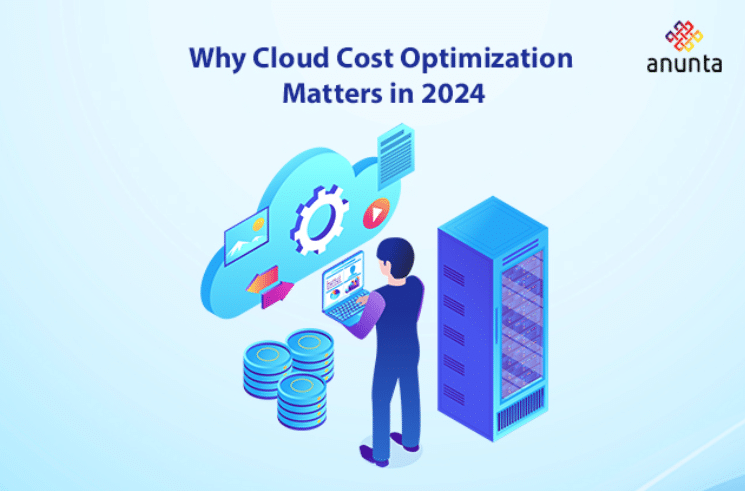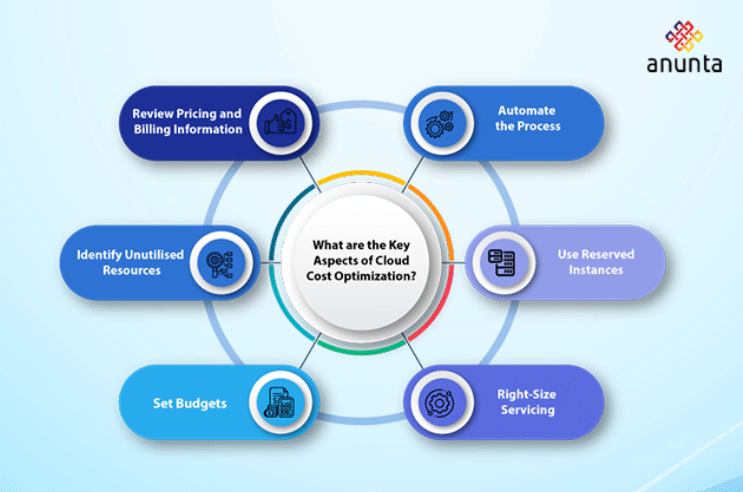
Let’s say you have a monthly budget that you would like to use sensibly without overspending on any item. This idea is comparable to cloud optimization. It’s about controlling spending and keeping cloud service costs down while ensuring you get the most value and performance for your money. These days, cloud computing is critical to company operations. It facilitates data storage, provides operational support, and performs similar digital tasks.
Cloud optimization helps save more money in the business, operate more efficiently, and invest in growth and innovation. It is considered one of the most innovative ways to ensure that there are cloud services without overspending.
Cloud cost optimization combines various strategies, techniques, tools, and plans to help businesses reduce cloud costs and maximize the cloud’s value. It refers to minimizing cloud computing costs while maintaining and improving the efficiency and scalability of the company.
In the cloud optimization process, there is an evaluation of current usages, determining the inefficiencies, and adjusting resource allocation to understand how expenses can be saved for the company. In addition, there are other benefits, such as improving the performance of cloud-based applications. There is continuous monitoring and optimization of the cloud-based services, and through this monitoring, businesses can swiftly adapt to the changes and improve their efficiency.
Cloud cost optimization helps businesses plan effectively to save on their budget. This is possible with the following aspects:

Cloud cost optimization works in reviewing the billing details of cloud vendors. It leverages the billing information to identify the high-cost areas and understand where businesses can save money. It helps prioritize and analyze high-spend services and workflows.
Cloud optimization is also possible when businesses can identify unutilized resources where the expenditure is not worth it. There are some instances in which the administrators and developers provision a temporary server for a specific task and need to remember to de-provision it, so it is essential to identify such unutilized resources.
Cloud cost optimization helps businesses to set budgets effectively. The arbitrary number can never be the exact budget; therefore, there must be a realistic number to determine how much to spend. There must be no over-provisioning or under-provisioning of the budget; thus, cloud optimization works on this model.
Right-sizing services involve modifying them to make them more efficient for the company. Cloud cost optimization helps ensure that all computing resources like storage, graphics, databases, and other options are correctly sized based on workloads. There should be no over or under-provisioning in the sizing, as it can affect the efficiency of the business.
Reserved instances are the prepaid computer instances that come with price discounts. Cloud cost optimization helps cloud providers leverage long-term commitment options through reserved instances. There are saving plans with these reserved instances.
Automating the whole resource lifecycle of creating and terminating the resources, server, and cloud accounts helps eliminate the hassles of the manual task. Thus, it helps save on expenses for the company. Cloud optimization finds every way to save money for businesses and ensure easy and efficient delivery of services for the industry.
Businesses are increasingly relying on cloud services for various operations. Thus, cloud optimization can play a significant role in impacting the bottom line of the company. It can lead to substantial savings that can be reinvested in other business areas.
It helps businesses to scale their businesses and other operations effectively. It manages the budget effectively; thus, companies can take advantage of this feature and scale their business in 2025 with cloud optimization features. There are auto-scaling options included as well, it helps companies provide the required services on a real-time basis, thus helping them to reach a new scalable level easily.
When effective cost optimization is implemented, it will provide better information to predict the financial status in the future. There is transparency in the cost allocation; each department’s cloud usage and costs are tracked separately, so it helps to have a clear idea about the company’s financial status. This straightforward idea about economic status will help businesses take control of their finances plan and budget more accurately. This feature is essential to stabilizing the company and making strategic, informed decisions.
Reduced cloud costs will free up the financial resources of businesses and enable them to invest more in innovation and other such developmental activities. This will foster agility by allowing companies to make decisions more quickly based on market changes and technological developments.
The regular reviews through cloud optimization help ensure that there are up-to-date technologies for the companies. It helps businesses improve their performance and ensure the practical reliability of their applications and services. There would be proactive optimization in the company’s performance by avoiding bottlenecks and downtime, ultimately leading to higher benefits for the company.
In today’s fast-evolving digital ecosystem, cloud cost optimization isn’t just a financial strategy—it’s a business imperative. At Anuntanologies, we understand that every organization’s cloud journey is unique. By implementing intelligent optimization practices—right-sizing resources, automating workloads, and leveraging reserved instances—businesses can transform their cloud environments into engines of efficiency and innovation.
As we move into 2025 and beyond, companies that embrace proactive cloud cost optimization will gain greater financial control, operational agility, and the freedom to innovate. Partnering with experts like Anunta ensures that your cloud investments don’t just reduce costs—they fuel sustainable growth, scalability, and performance across every layer of your digital infrastructure.
Start optimizing today. Empower your business to do more with less and turn your cloud into a competitive advantage.
A: Cloud cost optimization is a process of reducing the expenses of cloud computing, and at the same time, it helps maintain the business’s performance, efficiency, and scalability. This cloud optimization involves strategies to ensure effective resource allocation so that companies can avoid unnecessary spending and enhance their overall growth.
A: There are various methods through which businesses can achieve cloud cost optimization. It includes the process of right-sizing, utilizing reserved instances, auto-scaling, using savings plans, automating the system, and other such methods. With these cloud cost optimization methods, businesses can save on expenses and enhance their operations to increase effectiveness.
A: Cloud optimization can result in businesses saving a significant amount of money, which can later help them invest in more productive segments. Companies can cut their cloud infrastructure costs and create an opportunity to invest in strategic needs such as innovation and growth. It provides ample opportunities to save expenses, plan, and spend effectively; therefore, businesses are moving towards cloud cost optimization.
A: When the companies are not using cloud cost optimization, then the businesses may face excessive expenditure on maintaining unnecessary expenses, budget overruns, inefficient resource usage, and reduced financial control.
Research Review with Anunta’s CTO | Jan 14 | 12PM PST/3PM EST